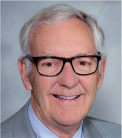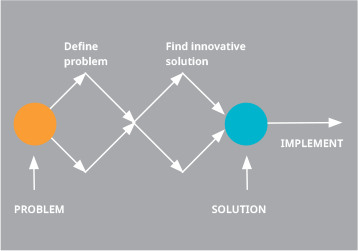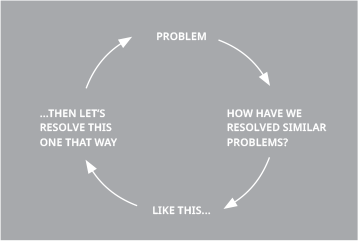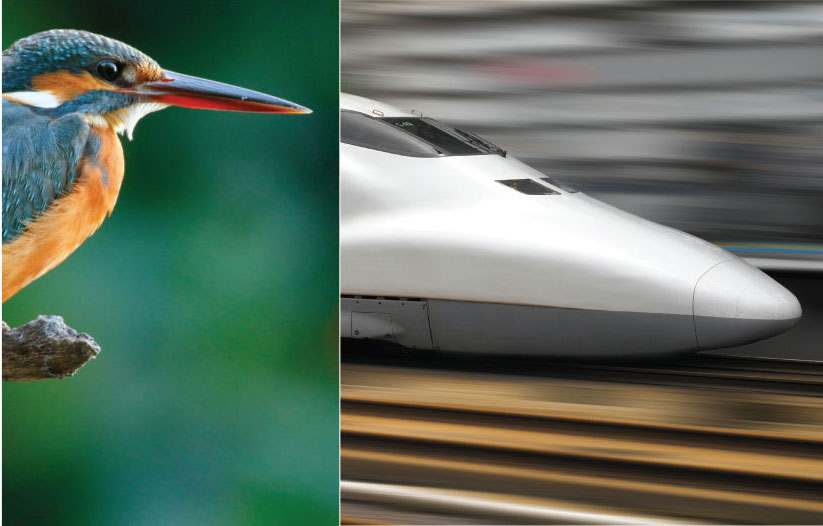Winter 2023
Turning To Nature For New Ideas
BY STUART G. WALESH, PH.D., P.E., F. NSPE
 When faced with a new technical or nontechnical problem, have you, individually or as a team, participated in a conversation something like the following? The leader asks, "Have we encountered a similar problem?" One person says, "Yes." The leader asks, "How did we solve it?" Another person explains how. The leader concludes, "then let’s solve this one that way."
When faced with a new technical or nontechnical problem, have you, individually or as a team, participated in a conversation something like the following? The leader asks, "Have we encountered a similar problem?" One person says, "Yes." The leader asks, "How did we solve it?" Another person explains how. The leader concludes, "then let’s solve this one that way."
Good decision, because we know that the process we just followed usually works—it solves problems. We are practicing design fixation, also called reproductive thinking or the Einstellung Effect, where the German word Einstellung means a rigid, mechanized mindset.
In celebrating our successful problem solution, we may not realize the bad news. Our intentional or unwitting application of reproductive thinking causes us to miss creative-innovative opportunities and the attendant benefits for us and those we serve. Design fixation closes the door to creative or innovative problem solving because we become prisoners of the past. We are stung by Einstellung. As so nicely stated by economist John Maynard Keynes, "The difficulty lies not so much in developing new ideas as in escaping from the old ones."
A Fresh-Thinking Toolbox
Fortunately, we have many tools available to help us generate new ideas—to stimulate individuals and, more powerfully, groups to think deeper and wider during the problem definition and solution process. My studies led me to many tools— biomimicry, borrowing brilliance, fishbone diagramming, Medici effect, mind mapping, Ohno Circle, process diagramming, six thinking caps, taking a break, theory of inventive problem solving, and what if.
These tools recognize that while creative-innovative ideas lie within most of us, we need fresh-thinking mechanisms to release them. Our organizations are loaded with creative-innovative ideas. Our personnel, by virtue of their varied educations and experiences, are a gold mine of them. Mine the gold for everyone’s benefit by moving from Einstellung to fresh thinking, stimulated by one or more of the available tools.
Biomimicry
Let’s illustrate the potential power of the tool set by describing the use of one, biomimicry. Author Janine M. Benyus, in her book Biomimicry: Innovation Inspired by Nature, defines biomimicry as the study of nature’s models and then imitating or taking inspiration from them to solve human problems.
Research scientist Yoseph Bar-Cohen states that "biomimetics (his term for biomimicry) is the field of science and engineering that seeks to understand and to use nature as a model for copying, adapting, and inspiring concepts and designs." He views nature as a "giant laboratory" in which "trial and error experiments" occur within the evolutionary process.




The beak of the Kingfisher inspired Eiji Nakatsu, chief engineer of the West Japan Railway, and his team to design the lead unit on the Japanese high-speed Shinkansen train.
I like the "human problems" part of Benyus’ definition because it reminds me of what we engineers say we do. We meet society’s physical needs while holding public protection paramount. Howard Schultz, business leader and Starbucks CEO, said, "We’re in the people business serving coffee, not in the coffee business serving people." We engineers are in the people business serving engineering, not in the engineering business serving people. People first. We are more likely to meet that ambitious mission if we use creative-innovative means—instead of "how we’ve always done it."
Consider some biomimicry examples, mostly from within engineering. Seashell shapes inspired the design of the Sydney Opera House with each half of each shell being a segment of a sphere. Originally, the architect wanted parabolicshaped shells, which proved unworkable, so the engineering firm Arup developed the sphere-segment idea.
Nature’s honeycomb objects, such as the hexagonal cellular structure within beehives, inspired the design of aircraft structural elements because of the need for high strength and low weight, that is, a high strength-to-weight ratio. Mechanical engineering professor Carmen Torres-Sanchez said, "We mechanical engineers are obsessed with how solid, homogeneous materials behave, but when you look at nature, there’s nothing that is really homogenous out there." She advocated porosity graduation meaning designing structural materials with advantageous cavities similar to those found in bamboo, tree trunks, and bones.
The beak of the Kingfisher inspired Eiji Nakatsu, chief engineer of the West Japan Railway, and his team to design the lead unit on the Japanese high-speed Shinkansen train. Bird watching was Nakatsu’s hobby. He and his team experimented by firing various shaped bullets, inspired by bird beak shapes, into a pipe until they found the optimum shape.
An observant and curious 14-year-old farm boy, Philo Farnsworth, observed neat parallel rows of crops on his uncle’s Idaho farm. This caused him to think of electronically capturing an image, in line-by-line slices, transmitting them, and reassembling them into the original image. Philo Farnsworth persisted, continued his study and experimentation and, at age 20, he demonstrated the first working television that used electronic scanning on both the pickup and display devices.
Valves and chambers in animal and human hearts led to design of the peristaltic pump in which sterile or reactive liquids are squeezed in the desired direction so that the pumping mechanism does not contact the pumped liquid.
A palm tree forest inspired Santiago Calatrava, a Spanish engineer and architect, to design the columns in the train station in Lisbon, Portugal. The twisting ability of the human spine stimulated Calatrava to design the Turning Torso skyscraper, the tallest building in Malmo, Sweden. He designed a portion of the Milwaukee, Wisconsin, art museum with wings that can open to the sky.
Burrs that stuck to his clothes and to his dog’s coat after a hunting trip inspired a Swiss electrical engineer, George de Mestral, to create the now almost omnipresent Velcro. When de Mestral examined the burrs under a microscope, he saw many stiff hooked spines that caught on almost anything. Seeing this, he thought about the possibility of repeatedly binding two materials, one with hooks and one with hoops, in a reversible manner.
Arthur Morgan, a 20th Century Renaissance engineer, was unusually creative and innovative. For example, he authored Minnesota drainage laws, founded an engineering firm, established the Miami Conservancy District, rescued Antioch College, organized the Tennessee Valley Authority, and influenced the development of rural universities in India. He said, "Much of my free time as a boy was spent in the woods and swamps about St. Cloud, Minnesota, where curiosity took the form of observation of earth and sky, streams, plants, and animals. As a result of this habit of curiosity and observation, my mind was stored with a vast miscellany of facts which served as the material for thinking," and, we might add, for lifelong creating and innovating.
Finally, the ultimate scientist, engineer, and artist, Leonardo da Vinci, said, "The wisest and noblest teacher is nature itself." Apparently influenced by that philosophy, he showed how to portray three-dimensional effects on a two-dimensional medium, create highly detailed and instructive drawings of inside the human body, depict the landscape as is would be seen from a high altitude, and establish wave theory. He also suggested the possibility of windmills, scissors, folding furniture, parachutes, helicopters, anemometers, pontoon bridges, life preservers, diving suits, waterway locks, and more. Maybe we should get out more, as into nature.

A palm tree forest inspired Santiago Calatrava, a Spanish engineer and architect, to design the columns in the train station in Lisbon, Portugal. The twisting ability of the human spine stimulated Calatrava to design the Turning Torso skyscraper, the tallest building in Malmo, Sweden. He designed a portion of the Milwaukee, Wisconsin, art museum with wings that can open to the sky.
Double-Diamond Thinking Process
My exploration of neuroscience basics, creativity-innovation case studies, and tools used to encourage collaboration and fresh thinking convince me that we, individually or as teams, will be more creative and innovative if we use a whole-brain approach. Let’s strive to use our left and right hemispheres so that the logical, verbal, and abstract capabilities of our left side interact synergistically with the emotional, intuitive, and synthesizing capabilities of our right side. As concisely noted by artist Betty Edwards, who authored a book with the dual-meaning title Drawing On the Right Side of the Brain, "Half a brain is better than none. A whole brain would be better."
The double-diamond process nicely encapsulates whole-brain thinking, as an alternative to the Einstellung Effect.
In the first diamond, we use divergent thinking to explore possible problem definitions—more is better at this stage and almost anything may be suggested. Divergent thinking is all about generating ideas. Scientist Linus Pauling said, "The best way to have a good idea is to have lots of ideas." American writer John Steinbeck noted, "Ideas are like rabbits. You get a couple, and learn how to handle them, and pretty soon you have a dozen." After thorough divergent thinking, we use convergent thinking to select the best problem definition to complete the first diamond.
For some engineers, giving adequate attention to the problem-definition diamond is challenging because of our impatient "let’s get it done" attitude. This mindset is often admirable. However, rushing through the first diamond may lead to solving the wrong problem, missing benefits that could arise from a solution, failing to serve some stakeholders, spending more than necessary, or harming the environment. "A problem well stated is a problem half-solved," according to engineer Charles F. Kettering.
Armed with a solid problem definition, move into the second diamond and repeat the broad and deep divergent-convergent thinking process to fully explore the possible solutions and then select one. Clearly, the diamonds must be done in the indicated order—they force discipline and stimulate broad and deep individual and group thinking.
Fortunately, as noted earlier, we have many tools available to use during the two divergent-convergent phases. These methods stimulate individuals and, more powerfully, groups to think much deeper and wider—to generate more ideas while working through the double-diamond process. For example, biomimicry, as suggested by the diverse practical examples of its application, is a powerful tool to use in the divergent stage of the second diamond.
Concluding Thoughts
In our increasingly complex world, engineering’s ideology of meeting society’s physical needs while holding public protection paramount will increasingly challenge professional engineers. The double-diamond process and tools, such as biomimicry, can help us meet the challenge.
, Ph.D., P.E., F.NSPE, is a consultant, teacher, and author. This article draws heavily on one of his most recent books, Introduction to Creativity and Innovation for Engineers. He can be reached at stu-walesh@comcast.net.


